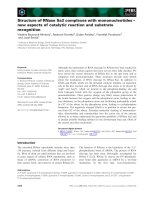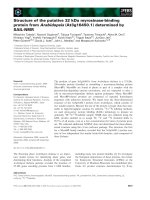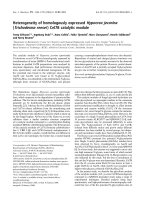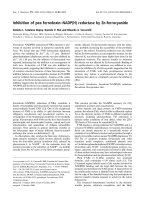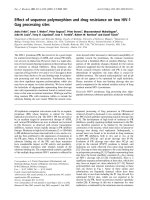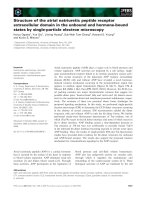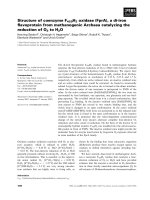Báo cáo khoa học: Structure of the complex of a yeast glucoamylase with acarbose reveals the presence of a raw starch binding site on the catalytic domain doc
Bạn đang xem bản rút gọn của tài liệu. Xem và tải ngay bản đầy đủ của tài liệu tại đây (1.08 MB, 11 trang )
Structure of the complex of a yeast glucoamylase with
acarbose reveals the presence of a raw starch binding site
on the catalytic domain
Jozef S
ˇ
evc
ˇ
ı
´
k
1
, Eva Hostinova
´
1
, Adriana Solovicova
´
1
, Juraj Gas
ˇ
perı
´
k
1
, Zbigniew Dauter
2
and Keith S. Wilson
3
1 Institute of Molecular Biology, Slovak Academy of Sciences, Bratislava, Slovakia
2 Synchrotron Radiation Research Section, Macromolecular Crystallography Laboratory, NCI, Argonne, IL, USA
3 York Structural Biology Laboratory, University of York, UK
In addition to catalyzing the removal of b-d-glucose
from the nonreducing ends of starch and other related
poly and oligosaccharides, glucoamylase is able to
degrade a-1,6-glucosidic linkages, although much less
effectively. The enzyme is produced by many moulds
and yeasts. The primary industrial use of glucoamylase
is in the production of glucose and fructose syrups,
which in turn serve as a feedstock for biological fer-
mentations in the production of ethanol or in the
production of high fructose sweeteners [1]. Using the
classification of glycoside hydrolases into nearly 100
families on the basis of sequence similarity, glucoamy-
lase belongs to family 15 [2] ( />CAZY/).
The most thoroughly studied glucoamylase is that
from Aspergillus awamori variety X100. The three-
dimensional structure of its catalytic domain has been
described in detail at a range of pH [3,4]. Subse-
quently, its interactions with different carbohydrate
inhibitors were defined by the determination of
Keywords
acarbose; glucoamylase; starch binding site;
sugar tongs; X-ray structure
Correspondence
J. S
ˇ
evc
ˇ
ı
´
k, Institute of Molecular Biology,
Slovak Academy of Sciences, Du
´
bravska
´
cesta 21, 84551 Bratislava, Slovakia
Fax: +421 259307416
Tel: +421 259307435
E-mail:
(Received 16 January 2006, revised 10
March 2006, accepted 15 March 2006)
doi:10.1111/j.1742-4658.2006.05230.x
Most glucoamylases (a-1,4-d-glucan glucohydrolase, EC 3.2.1.3) have
structures consisting of both a catalytic and a starch binding domain. The
structure of a glucoamylase from Saccharomycopsis fibuligera HUT 7212
(Glu), determined a few years ago, consists of a single catalytic domain.
The structure of this enzyme with the resolution extended to 1.1 A
˚
and that
of the enzyme–acarbose complex at 1.6 A
˚
resolution are presented here.
The structure at atomic resolution, besides its high accuracy, shows clearly
the influence of cryo-cooling, which is manifested in shrinkage of the mole-
cule and lowering the volume of the unit cell. In the structure of the com-
plex, two acarbose molecules are bound, one at the active site and the
second at a site remote from the active site, curved around Tyr464 which
resembles the inhibitor molecule in the ‘sugar tongs’ surface binding site in
the structure of barley a-amylase isozyme 1 complexed with a thiomalto-
oligosaccharide. Based on the close similarity in sequence of glucoamylase
Glu, which does not degrade raw starch, to that of glucoamylase (Glm)
from S. fibuligera IFO 0111, a raw starch-degrading enzyme, it is reason-
able to expect the presence of the remote starch binding site at structurally
equivalent positions in both enzymes. We propose the role of this site is to
fix the enzyme onto the surface of a starch granule while the active site
degrades the polysaccharide. This hypothesis is verified here by the prepar-
ation of mutants of glucoamylases Glu and Glm.
Abbreviations
Glu, glucoamylase structure at 1.7 A
˚
(1AYX); Glu-A, glucoamylase–acarbose complex at 1.6 A
˚
resolution; Glu1.1, glucoamylase at 1.1 A
˚
resolution.
FEBS Journal 273 (2006) 2161–2171 ª 2006 The Authors Journal compilation ª 2006 FEBS 2161
structures in complex with 1-deoxinojirimycin [5], acar-
bose [6] and d-gluco-dihydroacarbose [7,8]. These
structures define the positions of malto-oligosaccharide
residues in at least the )1 and +1 subsites labeled
according to the nomenclature proposed by [9] and
identify interactions between substrates and active site
amino acid side-chains. The structure of the starch
binding domain of A. niger glucoamylase was solved
by NMR in its native state [10] and in a complex with
b-cyclodextrin [11]. Crystal structures of an intact two-
domain prokaryotic glucoamylase were determined
from the clostridial species Thermoanaerobacterium
thermosaccharolyticum with and without acarbose [12].
In all of these enzymes the N-terminal starch binding
domain has 18 antiparallel strands arranged in b-sheets
of a super-b-sandwich, while the C-terminal catalytic
domain is an (a ⁄ a)
6
barrel.
Different strains of the dimorphous yeast Saccharo-
mycopsis fibuligera produce a set of closely related
glucoamylases. Two of them, (Glu; strain HUT7212)
and Glm (strain IFO 0111) from the GLU [13] and
GLM [14] genes, consist of 492 and 489 amino acid
residues, respectively, with a sequence identity of
60% and a similarity of 77%, Fig. 1. The two enzymes
differ in biochemical properties, in particular in the
ability to digest raw starch. While Glu adsorbs to, but
does not digest raw starch, Glm adsorbs well to starch
granules and is capable of raw starch digestion. The
glucoamylases from Aspergillus niger and A. awamori
prefer longer malt-oligosaccharides as substrates,
which is also the case for S. fibuligera glucoamylases
[15].
The determination of the crystal structure of recom-
binant glucoamylase Glu at 1.7 A
˚
resolution was
reported earlier [16]. The core of the enzyme is an
(a ⁄ a)
6
barrel known in SCOP nomenclature [17] as a
six-helical hairpin toroid, and is closely similar to that
of the catalytic domain of A. awamori and T. thermos-
accharolyticum glucoamylases, with the active site at
the narrower end of barrel. There is no terminal
starch-binding domain, and this is clearly also true for
the closely related Glm, for which a homology model
was proposed [14]. Thus the S. fibuligera glucoamylas-
es Glu and Glm differ from the other characterized
glucoamylases in that the raw-starch affinity site is an
integral part of the single catalytic domain.
In this paper, two structures are described: that of
the glucoamylase Glu with the resolution extended to
Fig. 1. Sequences of glucoamylases Glu
(upper line) and Glm (lower line). Identical
residues are underlined. Catalytic residues
(Glu210, Glu456) are marked with an arrow.
Residues which represent the raw starch
binding site (Arg15, His447, Asp450,
Thr462, Tyr464) are in bold.
Glucoamylase raw starch binding site J. S
ˇ
evc
ˇ
ı
´
k et al.
2162 FEBS Journal 273 (2006) 2161–2171 ª 2006 The Authors Journal compilation ª 2006 FEBS
1.1 A
˚
(Glu1.1) and that of its complex with acarbose
at 1.6 A
˚
resolution (Glu-A). One acarbose binds at the
expected catalytic site, and we propose that the second
site corresponds to the remote starch binding site. Five
residues (Arg15, His447, Asp450, Thr462 and Tyr464)
which are important in the remote starch binding site
in Glu are conserved in Glm (Arg15, His444, Asp447,
Thr459 and Phe461). However, a key residue which is
central for the remote acarbose binding is different in
the two enzymes: Tyr464 in Glu versus Phe461 in Glm
(Fig. 1). To confirm that the remote binding site is
essential for raw starch binding, the above amino acids
were mutated and the mutants tested for their ability
to adsorb to and digest raw starch.
Results and discussion
Description of the structures
There is one molecule in the asymmetric unit of both
structures composed of a single domain consisting of
14 helices, 12 of them forming an (a ⁄ a
6
) barrel as
expected from our previous native structure [16]. The
active site is at the narrower end of the barrel as
mapped by the presence of ligands (Tris in Glu1.1 or
acarbose in the Glu-A structure).
Accuracy of models
As expected, the accuracy of the structure Glu1.1 at
atomic resolution is higher than that of Glu-A or Glu.
The overall coordinate error for Glu1.1 and Glu-A
estimated from the r
A
plot [18], estimated standard
uncertainty (ESU) based on R and R
free
factors (the
Cruickshank’s dispersion precision indicator DPI [19],
and the average temperature factors for protein atoms,
water molecules and ligands are given in Table 1. The
temperature factors are in good agreement with esti-
mates from the Wilson plot [20].
The Ramachandran plot [21] calculated by the pro-
gram procheck [22] for Glu1.1 and Glu-A shows that
in both structures, there are > 92% of residues in the
most favored regions, the rest in additionally allowed
regions except Ala339 and Ser357 which are in gener-
ously allowed regions. The electron density for both
residues in the two structures is clear and all main-
chain atoms are well ordered, which confirms that the
deviation of torsion angles from ideal geometry of
these two residues is an intrinsic feature of the struc-
ture. In Glu1.1 there is another residue, Ser305 in the
generously allowed region. This residue is part of the
loop Gly302–Ser306, which is poorly ordered in this
structure (see below).
In both structures for most of the residues the x
angle deviates significantly from planarity. This is
reflected in the G-factor calculated by procheck
(Table 2) in which the x angles score for Glu1.1 and
Glu-A has a value of )0.05 and )0.06, respectively,
with 489 contributors. This confirms that the peptide
bond deviates from planarity by up to 20° as observed
in a number of atomic resolution structures. The aver-
age value for x angle in Glu1.1 and Glu-A structures
Table 1. Refinement statistics. ESU, estimated standard uncer-
tainty.
Glu-A Glu1.1
Molecules in asymmetric unit 1 1
R (%) 12.0 14.6
R
free
(%) 16.0 16.1
Model – atom sites 3946 3853
Solvent molecules 810 949
Average B-values (A
˚
2
)
Protein atoms 13.7 13.4
Tris 17.8
Acarbose 12.7 ⁄ 33.1
Phosphate anion 32.0
Solvent molecules 33.2 33.5
Wilson plot (A
˚
2
) 15.6 10.4
Coordinates ESU based
on R ⁄ R
free
(A
˚
)
0.117 ⁄ 0.077 0.033 ⁄ 0.031
r
A
error estimate (A
˚
) 0.04 0.02
Stereochemical restraints r.m.s. (r)
Bond distances (A
˚
) 0.011 (0.021) 0.007 (0.021)
Bond angles (°) 1.609 (1.965) 1.204 (1.939)
Chiral centers (A
˚
3
) 0.159 (0.200) 0.079 (0.200)
Planar groups (A
˚
) 0.015 (0.020) 0.008 (0.020)
B-factors restraints
Main-chain bond (A
˚
2
) 0.938 (1.500) 0.838 (1.500)
Main-chain angle (A
˚
2
) 1.535 (2.000) 1.389 (2.000)
Side-chain bond (A
˚
2
) 2.237 (3.000) 1.812 (3.000)
Side-chain angle (A
˚
2
) 3.318 (4.500) 2.684 (4.500)
Table 2. G-factors calculated by PROCHECK.
Glu1.1 Glu-A
Dihedral angles (°)
Phi–Psi distribution 0.15 0.15
Chi1–Chi2 distribution 0.02 0.02
Chi1 only 0.13 0.10
Chi3 and Chi4 0.51 0.32
Omega )0.46 )0.43
Average score )0.05 )0.06
Main-chain covalent forces
Main-chain bond lengths (A
˚
) 0.63 0.56
Main-chain bond angles (°) 0.44 0.39
Average score 0.52 0.46
Overall average 0.18 0.15
J. S
ˇ
evc
ˇ
ı
´
k et al. Glucoamylase raw starch binding site
FEBS Journal 273 (2006) 2161–2171 ª 2006 The Authors Journal compilation ª 2006 FEBS 2163
is 179.6 and 179.5, respectively, with rmsd of 5.7° in
both.
The Glu1.1 structure
The Glu structure (1AYX) was described in detail pre-
viously. Superposition of the structures Glu1.1 and
Glu based on all CA atoms, calculated by the program
lsqkab, shows that the two structures are nearly iden-
tical with rmsd 0.38 A
˚
. The maximum deviation
(3.63 A
˚
) does not represent any important difference
as it relates to the C-terminal residue. Omitting 16
atoms from the surface loops for which deviation was
above 1 A
˚
, the rmsd falls to 0.32 A
˚
. The superposition
reveals that the molecule contracts on cryo-cooling
with the surface regions being shifted towards the cen-
tre by 0.3 A
˚
, keeping the central part of the molecule
intact. This is reflected in the unit cell volume which is
510 156 A
˚
3
at 292 K but falls to 479 022 A
˚
3
at 110 K.
Some of the residues poorly determined in the Glu
structure became clearer in the Glu1.1 and all six resi-
dues with two conformations in Glu have a single con-
formation in Glu1.1.
Inspection of the Glu1.1 electron density shows that
it is very clear in the entire molecule with only a single
conformation for each residue suggesting that the
molecule has a rigid fold. Nevertheless the segment
Gly302-Glu303-Ser304-Ser305-Ser306 located at the
opposite end of the barrel to the active site has weaker
electron density and the temperature factors of the
atoms in this segment are 31 A
˚
2
, 2.35 times above
the average B for the structure. The high flexibility of
this loop does not appear to be connected with the cat-
alytic function. One explanation lies in the fact that
the loop protrudes from the surface of the molecule
and does not form any additional contacts with the
molecule.
The Glu-A structure
The Glu-A structure was refined to a low R factor
(Table 1) and the electron density is clear through the
whole structure. While the Gly302-Ser306 loop has an
average temperature factor of 26 A
˚
2
, compared with
an average value for the whole protein of 13.7 A
˚
2
, the
electron density is considerably better in comparison
to the Glu1.1 structure. This is due to the close prox-
imity of a phosphate anion (sodium phosphate buffer
was used in purification) which fills the gap between
the loop and the rest of the protein (Fig. 2B) forming
a number of direct and water-mediated hydrogen
bonds. One of the phosphate oxygen atoms forms
hydrogen bonds with a water molecule which belongs
to the cluster of water molecules and the Asp379 carb-
oxyl liganded to a Na
+
ion. Another Na
+
ion, sur-
rounded by five water molecules is bound to Ile177
carbonyl. All distances between the Na
+
and the sur-
rounding oxygen ligands are close to 2.42 A
˚
, the aver-
age distance observed in a set of protein structures
[23].
Superposition of the Glu-A and Glu1.1 structures
gives r.m.s. and maximum displacement of 0.47 and
4.47 A
˚
, respectively. Glu-A differs from Glu1.1 mainly
in the loop Ser9-Asn10-Tyr11-Lys12-Val13-Asp14-
Arg15-Thr16 where the differences between CA atoms
are up to 4.5 A
˚
(at Asn10). This conformational
change is caused by Arg15 which moves (CA moves
1.2 A
˚
) in order to interact with the acarbose sugar +1
causing reorientation of the whole loop.
Catalytic site
The catalytic reaction of glucoamylases proceeds with
inversion of configuration at the anomeric carbon
which requires a pair of carboxylic acids at the active
A
B
Fig. 2. Glu with two acarbose molecules
and a phosphate anion. The anion is hidden
below the active site acarbose in (A), but is
clearly visible in (B). The two views are rela-
ted by rotation around y-axis by 90° (drawn
using
MOLSCRIPT [50]).
Glucoamylase raw starch binding site J. S
ˇ
evc
ˇ
ı
´
k et al.
2164 FEBS Journal 273 (2006) 2161–2171 ª 2006 The Authors Journal compilation ª 2006 FEBS
site, one acting as general acid and the other as general
base [24]. The mechanism of hydrolysis consisting of
three steps involves proton transfer to the glycosidic
oxygen of the scissile bond from a general acid cata-
lyst, formation of oxocarbenium ion and a water-assis-
ted nucleophilic attack by a general base catalyst [24–
27]. In the glucoamylase from A. awamori and A. niger
Glu179 was identified as the general acid and Glu400
as the general base [4–6,28,29]. Superposition of
the A. avamori and A. niger structures with those of
S. fibuligera glucoamylase complexes with Tris and
acarbose shows that the corresponding residues are
Glu210, general acid and Glu456, general base. In the
Glu-A and Glu1.1 structures the distances between the
CA atoms of these two residues are 14.8 and 14.7 A
˚
and the shortest distances between the two carboxyl
groups are 7.3 and 7.6 A
˚
, respectively. The carboxyl
groups can easily adopt a distance of 9.2 A
˚
, typical for
inverting glycoside hydrolysis [24,30,31].
In the active site of the native Glu1.1 there is a Tris
molecule which forms direct hydrogen bonds with
Arg69, Asp70 and one bond, mediated by a water
molecule, with Glu210. Hydrogen bonds formed
between the enzyme and Tris are the same as observed
previously [16].
In the Glu-A complex there are two acarbose mole-
cules: one in the active site and the other on the sur-
face of the enzyme about 25 A
˚
away, Fig. 2. The
active site acarbose fits tightly into the pocket (Fig. 3)
and the electron density for all the acarbose atoms is
very clear (Fig. 4A). The acarbose has a well-defined
conformation that corresponds to that observed in the
complex with the fungal glucoamylase from A. awa-
mori var. X100 at pH 4 [8]. The sugars )1 and +1,
labeled according to the nomenclature proposed by [9],
form several hydrogen bonds with the enzyme and
confirm the identity of the active site residues. Sugars
+2 and +3 do not form any hydrogen bonds with the
enzyme, however, they do stack nicely against the aro-
matic rings of Tyr351 and Trp139, respectively. The
distances between the sugars and the aromatic rings of
the two residues are 4A
˚
. The mode of acarbose
binding to the active site readily explains the exogluca-
nase activity.
Raw starch binding site
The electron density for the surface acarbose (Fig. 4B),
is not as clear as that for the active site acarbose, sug-
gesting a higher mobility or a reduced occupancy,
probably caused by a neighboring molecule at a dis-
tance of about 3.5 A
˚
. This is reflected in the average
temperature factors which are 33 A
˚
2
for the surface
Fig. 3. Hydrogen bonds formed by acarbose
with the active site residues in stereo. The
catalytic residues are Glu210 and Glu456
(drawn using
MOLSCRIPT).
Fig. 4. Electron density for (A) the active site and (B) the remote
surface acarbose (drawn using
BOBSCRIPT [51]).
J. S
ˇ
evc
ˇ
ı
´
k et al. Glucoamylase raw starch binding site
FEBS Journal 273 (2006) 2161–2171 ª 2006 The Authors Journal compilation ª 2006 FEBS 2165
acarbose in contrast to the 13 A
˚
2
for the active site
ligand. The surface acarbose in the Glu-A structure,
which we propose to correspond to a raw starch bind-
ing site, is localized in the crevice formed by Arg15,
His447, Asp450, Thr462, Tyr464 and Ser465. There
are six H-bonds between this remote acarbose and the
enzyme, two direct, His447 ND1 – O3 (+ 2), Thr462
O – O2 (+ 2) and four mediated through one or two
water molecules, Asp450 N–W – O3 (+ 1), Asp450
OD1–W – O2 ()1), Asn451 N–W–W-O4 ()1), Ser465
N–W – O3 (+ 1). The second sugar ring of the acar-
bose stacks against the planar Arg15 guanidino group.
A space-filling model of glucoamylase with both
acarbose molecules is shown in Fig. 5. The surface
acarbose is curved around Tyr464 in the form of a
semicircle (Fig. 6) and captures the inhibitor molecule
as seen in the ‘sugar tongs’ binding site in barley
a-amylase isozyme 1 complexed with the substrate
analogue, methyl 4¢,4¢¢,4¢¢¢-trithiomaltotetraoside
[32,33] and a true oligosaccharide substrate [34]. A
similar situation was seen in the structure of the amy-
lomaltase–acarbose complex [35,36] in which the acar-
bose molecule winds around Tyr54. However, in those
structures the raw starch binding site is not part of the
catalytic but is located on a separate domain.
Mutations at the remote ligand binding site
To verify the hypothesis that the site on the Glu sur-
face interacting with acarbose represents the starch
binding site, the point mutants R15A, H447A, T462A
and a double mutant H447A, D450A were prepared
and tested for affinity to starch. Two approaches were
used: adsorption of enzymes in a test tube assay on a
native granular starch and mobility of enzymes in
native gels with and without copolymerized boiled
granular starch.
Adsorption of the wild-type Glu, its mutants and
Glm in test tube experiments is presented in Fig. 7.
The results show that affinity of Glu to native raw
starch was observed only at a high raw starch–enzyme
ratio: at a ratio of 100 mg raw starch)50 lg Glu only
10% of the enzyme was bound. Under the same condi-
tions, > 95% of the wild-type Glm was bound. The
Glu mutants did not bind at all.
The electrophoretic mobility of Glu and its mutants
are presented in Fig. 8. In a standard native gel
(Fig. 8A) the Glu and its mutants move to nearly the
same position while in the gel with a copolymerized
boiled granular starch (Fig. 8B) all Glu mutants move
significantly faster indicating that their affinity to the
gel matrix is lower.
As documented in our previous work [37], a similar
situation was found with the raw starch degrading
Glm. The Glm H444A, D447A mutant in the gel
containing starch moved faster than wild-type Glm
because of its impaired affinity towards the substrate.
The changes in electrophoretic mobility of native and
Fig. 5. A space filling model showing the complex of glucoamylase
with acarbose. Both acarbose molecules are in yellow. Tyr464 is in
green, Asp450 in red and Arg15 in blue. The rest of residues inter-
acting with the surface acarbose are hidden below it.
Fig. 6. Stereo picture of the surface acar-
bose curved around Tyr464 and the interact-
ing partners Arg15, His447, Asp450 and
Thr462 drawn using
MOLSCRIPT.
Glucoamylase raw starch binding site J. S
ˇ
evc
ˇ
ı
´
k et al.
2166 FEBS Journal 273 (2006) 2161–2171 ª 2006 The Authors Journal compilation ª 2006 FEBS
mutant glucoamylases demonstrate that mutations of
the amino acids proposed to be involved in binding of
the surface acarbose caused reduction of enzyme
adsorption on starch, proving that these amino acids
are involved in starch binding site in spite differing in
a key residue – Tyr464 in Glu versus Phe461 in Glm.
Biochemical analysis has shown that the double muta-
tion H444A, D447A retained specific activity on sol-
uble starch identical but caused significant reduction of
raw starch hydrolysis (to 12%) in comparison with the
wild-type enzyme.
Conclusions
The structures of the glucoamylases from S. fibuligera
belong to family 15 of the glycoside hydrolases. Most
of the currently characterized family members have a
two-domain structure, the small domain playing the
role of binding the enzyme to starch, allowing the lar-
ger catalytic domain to hydrolyze the starch substrate.
We showed previously that the S. fibuligera Glu
enzyme lacked the independent starch binding domain
while the catalytic domain was very similar to that of
other family 15 members. The close similarity in
sequence of the Glm enzyme indicated that it too
lacked the binding domain, and the modeled structure
was like that of Glu with a single domain.
Our present work has improved the resolution of
the native Glu structure, but has in addition revealed
the presence of a second acarbose (substrate analogue)
binding site on the surface of the enzyme, 25 A
˚
remote
from the catalytic site. The key residues involved in
the binding at this remote site have been mutated, and
the mutants shown to have greatly reduced starch
binding properties. These results strongly support the
hypothesis that the S. fibuligera glucoamylases have
evolved a starch binding site on the catalytic domain
quite distinct from that seen in other family 15 glyco-
side hydrolases.
Experimental procedures
In vitro mutagenesis
Site-directed mutagenesis was performed by Quick-
Change
TM
site-directed mutagenesis kit (Stratagene,
La Jolla, USA). Plasmid pVT100L-Glu [38] was used as a
template. The following oligonucleotides were used: GLU
R15A forward (5¢-ATTCAAACTATAAAGTTGACGCAA
CTGACTTGGAAACCTTC-3¢), GLU R15A reverse (5¢-
GAAGGTTTCCAAGTCAGTTGCGTCAACTTTATAGTT
TGAAT-3¢); GLU H447A forward (5¢- GCAAGTCATTT
TGGATGCTATTAATGATGATGGCTC-3¢), GLU H447A
reverse (5¢- GAGCCATCATCATTAATAGCATCCAAAA
TGACTTGC-3¢); GLU T462A forward (5¢- GAACAACTT
AACAGATATGCCGGTTATT CCACCGGT GCC-3¢), GLU
T462A reverse (5¢- GGCACCGGTGGAATAACCGGCA
TATCTGTTAAGTTGTTC-3¢); GLU H447A, D450A for-
ward (5¢-GCAAGTCATTTTGGATGCTATTAATGCTG
ATGGCTCCTTGAATGAAC-3¢), GLU H447A, D450A
Fig. 7. Adsorption to raw starch of Glu and R15A, H447A, T462A,
H447A + D450A mutants (A) and Glm (B) (n, wild types; d,
mutants). Enzyme at a level ranging from 0.01 to 0.5 mg were
added to a suspension of 100 mg of raw corn starch in 1 mL of
0.05
M sodium acetate, pH 5.6 (Glu) and pH 4.5 (Glm). The amount
of bound protein was calculated from the differences between the
initial enzyme activity and the free enzyme activity after binding.
AB
Fig. 8. Native PAGE without (A) and with boiled granular starch (B)
of Glu. Lanes 1,6, wt enzyme; lanes 2,7, mutant R15A; lanes 3,8,
mutant H447A; lanes 4,9, double mutant H447A, D450A; lanes
5,10 mutant T462A.
J. S
ˇ
evc
ˇ
ı
´
k et al. Glucoamylase raw starch binding site
FEBS Journal 273 (2006) 2161–2171 ª 2006 The Authors Journal compilation ª 2006 FEBS 2167
reverse (5¢-GTTCATTCAAGGAGCCATCAGCATTAAT
AGCATCCAAAATGACTTGC-3¢).
All mutations were verified by DNA sequencing.
Enzyme preparation and purification
The recombinant glycosylated glucoamylases were prepared
in Saccharomyces cerevisiae AH22 as described previously
[14,38]. Yeast transformants were grown in medium con-
taining 1% yeast extract, 2% peptone, 2% glucose, for
48 h. Proteins which showed electrophoretic homogeneity
were obtained from extracellular media after ultrafiltration
through Amicon PM-30 membrane, molecular sieving chro-
matography on Superose 12P and ion exchange chromato-
graphy on FQ (both from Amersham Bioscience, Vienna,
Austria).
Polyacrylamide gel electrophoresis
Polyacrylamide gel electrophoresis was performed under
native conditions. Concentration gel was omitted. Two
types of gels were used: (1) Standard 10% polyacrylamide
gel: 1.25 mL of 1.5 m TrisHCl buffer, pH 8.8, 1.45 mL of
water, 2.2 mL of acrylamide solution (30%), 60 lL of 10%
ammonium persulfate solution and 2.5 lL N,N,N¢,N¢-tetra-
methylethylendiamine (TEMED) were mixed together. (2)
Polyacrylamide gel (7.5%) with copolymerized boiled gran-
ular corn starch: a suspension of 37.5 mg of starch in
1.25 mL of 1.5 m TrisHCl buffer, pH 8.8, and 2 mL of
water was boiled for 5 min and after cooling to room tem-
perature, 1.65 mL of acrylamide solution (30%), 60 lLof
10% ammonium persulfate solution and 2.5 lL TEMED
were added. The positions of glucoamylases were detected
with Coomassie Brilliant Blue R-250 staining (Merck,
Darmstadt, Germany).
Raw starch binding assay
The purified enzymes, in amounts of 0.01–0.5 mg mL
)1
protein, were added to a suspension of 100 mg of raw corn
starch in 1 mL of 0.05 m sodium acetate at pH 5.6 and 4.5
for Glu and Glm, respectively, which are optimal values for
soluble starch hydrolysis. The mixture was gently stirred
for 1 h at +4 °C. After centrifugation at 13 000 g for
5 min, the protein content expressed as enzyme activity of
the supernatant was assayed. The amount of the bound
protein was calculated from the difference between the ini-
tial enzyme activity and the free enzyme activity in the
supernatant after binding.
Enzyme activity
Glucoamylase activity was determined in the reaction mix-
ture containing 0.9% Leulier soluble starch in 0.05 m
sodium acetate, pH 5.6 and 4.5 for Glu and Glm, respect-
ively, incubated with enzyme at 40 °C for 15 min. An incre-
ment of glucose was measured as described previously [14].
Glucoamylase Glu
Crystallization, data collection and processing
The recombinant nonglycosylated Glu was prepared essen-
tially as reported in [39]. The enzyme was crystallized from
a protein solution of 10 mgÆmL
)1
in 50 mm acetate buffer
at pH 5.4 and 15% PEG 8K, as described earlier [40].
Protein for preparation of the glucoamylase–acarbose
complex was isolated in the same way as before, but Tris
was replaced by sodium phosphate buffer to avoid Tris
binding at the active site. Native crystals of the enzyme
were prepared as above and then 1 lL of the mother liquor
enriched by acarbose at a concentration of 10 mm was
added to drops (5 l L) containing native crystals a few days
before data collection.
X-ray data from native and complex crystals were collec-
ted at 110 K on EMBL beam lines BW7B to 1.1 A
˚
and
X11–1.6 A
˚
resolution, respectively, at the DORIS storage
ring (DESY, Hamburg, Germany). Each data set was col-
lected from a single crystal with a MAR Research (Ham-
burg, Germany) imaging plate scanner and processed with
denzo and scalepack [41]. A summary of data collection
and processing is given in Table 3.
Structure determination and refinement
All subsequent calculations were performed with programs
from the CCP4 package [42] unless otherwise indicated. As
the unit cell parameters of glucoamylase at 1.1 A
˚
resolution
(Glu1.1) and the glucoamylase–acarbose complex (Glu-A)
Table 3. Data statistics. Values in parentheses refer to the highest
resolution shell.
Glu-A Glu1.1
EMBL-Hamburg X-ray
source
Beamline X11 Beamline BW7B
Wavelength (A
˚
) 0.9096 0.834
Temperature (K) 100 100
Resolution range (A
˚
) 10–1.6 (1.62–1.60) 15–1.1(1.12–1.10)
Space group P2
1
2
1
2
1
P2
1
2
1
2
1
Cell parameters
a (A
˚
) 56.6 56.9
b (A
˚
) 85.3 85.7
c (A
˚
) 97.5 98.2
Unique reflections 59266 184868
Completeness (%) 94.5 (85.8) 93.5 (84.8)
R(I)
merge
a
(%) 4.3 (14.4) 5.9 (15.3)
I ⁄ r(I) 17.5 (4.2) 16.9 (2.4)
a
R(I)
merge
¼ S
h
S
i
|I
i
–<I>| ⁄S
h
S
i
I
Glucoamylase raw starch binding site J. S
ˇ
evc
ˇ
ı
´
k et al.
2168 FEBS Journal 273 (2006) 2161–2171 ª 2006 The Authors Journal compilation ª 2006 FEBS
were slightly different from those of Glu (1AYX), molecu-
lar replacement molrep [43], was used to position the
model in the new cells. Both structures were refined with
the program refmac [44] against 95% of the data with the
remaining 5% randomly excluded for cross-validation using
the free R factor ( R
free
) [45]. All data were included in the
final refinement step. After each refinement step, ARP [46]
was used for modeling and updating the solvent structure.
The Glu1.1 and Glu-A structures were initially refined
with isotropic temperature factors and in the later stages
with anisotropic temperature factors including the contribu-
tions from the hydrogen atoms. Hydrogen atoms were gen-
erated according to established geometrical criteria on their
parent C, N and O atoms. The temperature factors of the
hydrogen atoms were set equal to those of their parent
atom. Isotropic and anisotropic temperature factors, bond
lengths, and bond angles were restrained according to the
standard criteria employed by refmac. Occupancies of
water molecules were set to unity and not refined. The
models were adjusted manually between refinement cycles
on the basis of (3F
o
-2F
c
, a
c
) and (F
o
–F
c
, a
c
) maps using the
programs o [47] and xtalview [48]. The refinement statis-
tics are given in Table 1.
Glucoamylase Glm
Modeling of the structure
A model of the glucoamylase Glm structure was generated
using the modeller w4 package [49] using the known
structure of glucoamylase Glu and the sequence similarity
between the two enzymes [14].
Data Bank accession numbers
The atomic coordinates have been deposited in the Protein
Data Bank for Glu-A (2F6D) and Glu1.1 (2FBA). Gen-
Bank accession no(s) M17355 and AJ311587 belong to
GLU and GLM genes, respectively.
Acknowledgements
This work was supported by Howard Hughes Medical
Institute grant no. 75195–574601 and the grants
1 ⁄ 0101 ⁄ 03 and 2 ⁄ 1010 ⁄ 96 awarded by the Slovak
Grant Agency VEGA.
References
1 Saha BC & Zeikus JG (1989) Microbial glucoamylases:
biochemical and biotechnological features. Starch 41,
57–64.
2 Henrissat B (1991) A classification of glycosyl hydrolas-
es based on amino acid sequence similarities. Biochem J
280, 309–316.
3 Aleshin AE, Golubev A, Firsov LM & Honzatko RB
(1992) Crystal structure of glucoamylase from Aspergil-
lus awamori var. X100–2.2 A
˚
resolution. J Biol Chem
267, 19291–19298.
4 Aleshin AE, Hoffman C, Firsov LM & Honzatko RB
(1994a) Crystal structure of glucoamylase from Aspergil-
lus awamori var. X100–2.2 A
˚
resolution. J Mol Biol 238,
575–591.
5 Harris EMS, Aleshin AE, Firsov LM & Honzatko RB
(1993) Refined structure for the complex of 1-deoxyno-
jirimycin with glucoamylase from Aspergillus awamori
var. X100–2.4 A
˚
resolution. Biochemistry 32, 1618–1626.
6 Aleshin AE, Firsov LM & Honzatko RB (1994b)
Refined structure for the complex of acarbose with glu-
coamylase from Aspergillus awamori var. X100–2.4 A
˚
resolution. J Biol Chem 269, 15631–15639.
7 Stoffer B, Aleshin AE, Firsov LM, Svensson B & Hon-
zatko RB (1995) Refined structure for the complex of
d-gluco-dihydroacarbose with glucoamylase from Asper-
gillus awamori var. X100–2.2 A
˚
resolution: dual confor-
mations for extended inhibitors bound to the active site
of glucoamylase. FEBS Lett 358, 57–61.
8 Aleshin AE, Stoffer B, Firsov LM, Svensson B & Hon-
zatko RB (1996) Crystallographic complexes of glucoa-
mylase with maltooligosaccharide analogs: relationship
of stereochemical distortions at the nonreducing end to
the catalytic mechanism. Biochemistry 35, 8319–8328.
9 Davies GJ, Wilson KS & Henrissat B (1997) Nomencla-
ture for sugar-binding subsites in glycosyl hydrolases.
Biochem J 321, 557–559.
10 Sorimachi K, Jacks AJ, Le Gal-Coe
¨
ffet MF, Williamson
G, Archer DB & Williamson MP (1996) Solution struc-
ture of the granular starch binding domain of glucoa-
mylase from Aspergillus niger by nuclear magnetic
resonance spectroscopy. J Mol Biol 259, 970–987.
11 Sorimachi K, LeGal-Coe
¨
ffet MF, Williamson G, Archer
DB & Williamson MP (1997) Solution structure of the
granular starch binding domain of Aspergillus niger
glucoamylase bound to beta-cyclodextrin. Structure 5,
547–661.
12 Aleshin AE, Feng PH, Honzatko RB & Reilly PJ (2003)
Crystal structure and evolution of a prokaryotic glucoa-
mylase. J Mol Biol 327, 61–73.
13 Itoh T, Ohtsuki L, Yamashita I & Fukui S (1987) Nucleo-
tide sequence of the glucoamylase gene GLU1 in the
yeast Saccharomycopsis fibuligera. J Bacteriol 169, 4171–
4176.
14 Hostinova
´
E, Solovicova
´
A, Dvorsky´ R & Gas
ˇ
perı
´
kJ
(2003) Molecular cloning and 3D structure prediction of
the first raw-starch-degrading glucoamylase without a
separate starch-binding domain. Arch Biochem Biophys
411, 189–195.
15 Solovicova
´
A, Christensen T, Hostinova
´
E, Gas
ˇ
perı
´
kJ,
S
ˇ
evc
ˇ
ı
´
k J & Svensson B (1999) Structure–function
J. S
ˇ
evc
ˇ
ı
´
k et al. Glucoamylase raw starch binding site
FEBS Journal 273 (2006) 2161–2171 ª 2006 The Authors Journal compilation ª 2006 FEBS 2169
relationships in glucoamylases encoded by variant Sac-
charomycopsis fibuligera genes. Eur J Biochem 264, 756–
764.
16 S
ˇ
evc
ˇ
ı
´
k J, Solovicova
´
A, Hostinova
´
E, Gas
ˇ
perı
´
k J, Wil-
son KS & Dauter Z (1998) Structure of glucoamylase
from Saccharomycopsis fibuligera at 1.7 A
˚
resolution.
Acta Cryst D54, 854–866.
17 Lo Conte L, Ailey B, Hubbard TJ, Brenner SE, Murzin
AG & Chothia C (2000) SCOP: a structural classification
of proteins database. Nucleic Acids Res 28, 257–259.
18 Read RJ (1986) Improved Fourier coefficients for maps
using phases from partial structures with errors. Acta
Cryst A42, 140–149.
19 Cruickshank DWJ (1996) Macromolecular Refinement.
In Proceedings of the CCP4 Study Weekend (EJ Dod-
son, M Moore, A Ralph & S Bailey, eds), pp. 11–23.
SERC Daresbury Laboratory, Warrington, UK.
20 Wilson AJC (1942) Determination of absolute from rel-
ative X-ray data intensities. Nature 150, 151–152.
21 Ramakrishnan C & Ramachandran GN (1965) Stereo-
chemical criteria for polypeptide and protein chain con-
formations. II. Allowed conformations for a pair of
peptide units. Biophys J 5, 909–933.
22 Morris AL, Macarthur MW, Hutchinson EG & Thorn-
ton JM (1992) Stereochemical quality of protein struc-
ture coordinates. Proteins 12, 345–364.
23 Harding MM (2002) Metal-ligand geometry relevant to
proteins and in proteins: sodium and potassium. Acta
Cryst D58, 872–874.
24 McCarter JD & Withers SG (1994) Mechanisms of
enzymatic glycoside hydrolysis. Curr Opin Struct Biol 4,
885–892.
25 Sinnott ML (1990) Catalytic mechanism of enzymic
glycosyl transfer. Chem Rev 90, 1171–1202.
26 Konstantinidis A & Sinnot ML (1991) The interaction
of 1-fluoro-d-glucopyranosyl fluoride with glucosidases.
Biochem J 279, 587–593.
27 Tanaka Y, Tao W, Blanchard JS & Hehre EJ (1994)
Transition-state structures for the hydrolysis of alpha-d-
glucopyranosyl fluoride by retaining and inverting reac-
tions of glycosylases. J Biol Chem 269, 32306–32312.
28 Sierks MR, Ford C, Reilly PJ & Svensson B (1990) Cat-
alytic mechanism of fungal glucoamylase as defined by
mutagenesis of Asp176, Glu179 and Glu180 in the
enzyme from Aspergillus awamori. Protein Eng 3, 193–
198.
29 Svensson B, Clarke AJ, Svendsen I & Moller H (1990)
Identification of carboxylic acid residues in glucoamy-
lase G2 from Aspergillus niger that participate in cataly-
sis and substrate binding. Eur J Biochem 188, 29–38.
30 Davies GJ & Henrissat B (1995) Structures and mechan-
isms of glycosyl hydrolases. Structure 3, 853–859.
31 White A & Rose DR (1997) Mechanism of catalysis by
retaining beta-glycosyl hydrolases. Curr Opin Struct Biol
7, 645–651.
32 Robert X, Haser R, Svensson B & Aghajari N (2002)
Comparison of crystal structure of barley alpha-
amylase 1 and 2: implications for isozyme differences
in stability and activity. Biologia (Bratislava) 57 (Suppl.
11), 59–70.
33 Robert X, Haser R, Gottshalk TE, Ratajczak F,
Driguez H, Svensson B & Aghajari N (2003) The struc-
ture of barley alpha-amylase isozyme 1 reveals a novel
role of domain C in substrate recognition and binding:
a pair of sugar tongs. Structure 11, 973–984.
34 Robert X, Haser R, Mori H, Svensson B & Aghajari N
(2005) Oligosaccharide binding to barley a-amylase 1.
J Biol Chem 280, 32968–32978.
35 Przylas I, Terada Y, Fujii K, Takaha T, Saenger W &
Stra
¨
ter N (2000) X-ray structure of acarbose bound to
amylomaltase from Thermus aquaticus: implications for
the synthesis of large cyclic glucans. Eur J Biochem 267,
6903–6913.
36 Stra
¨
ter N, Przylas I, Saenger W, Terada Y, Fuji K &
Takaha T (2002) Structural basis of the synthesis of
large cycloamyloses by amylomaltase. Biologia (Brati-
slava) 57 (Suppl. 11), 93–99.
37 Gas
ˇ
perı
´
k J, Hostinova
´
E&S
ˇ
evc
ˇ
ı
´
k J (2005) Acarbose
binding at the surface of Saccharomycopsis fibuligera
glucoamylase suggests the presence of a raw starch-
binding site. Biologia (Bratislava) 60 (Suppl. 16),
177–180.
38 Gas
ˇ
perı
´
k J & Hostinova
´
E (1993) Glucoamylases
encoded by variant Saccharomycopsis fibuligera genes:
structure and properties. Curr Microbiol 27, 11–14.
39 Solovicova
´
A, Gas
ˇ
perı
´
k J & Hostinova
´
E (1996) High-
yield production of Saccharomycopsis fibuligera glucoa-
mylase in Escherichia coli, refolding, and comparison of
the nonglycosylated and glycosylated enzyme forms.
Biochem Biophys Res Com 224 , 790–795.
40 Solovicova
´
A, Gas
ˇ
perı
´
kJ,S
ˇ
evc
ˇ
ı
´
k J & Hostinova
´
E
(1997) Crystallization and preliminary X-ray analysis of
the Saccharomycopsis fibuligera glucoamylase expressed
from the GLU1 gene in Escherichia coli. Acta Cryst
D53, 782–783.
41 Otwinowski Z & Minor W (1997) Processing of X-ray
diffraction data collected in oscillation mode. Methods
Enzymol 276, 307–326.
42 Collaborative Computational Project, Number 4 (1994)
The CCP4 Suite: Programs for Protein Crystallography.
Acta Cryst. D50, 760–763.
43 Vagin A & Teplyakov A (1997) MOLREP: an auto-
mated program for molecular replacement. J Appl Cryst
30, 1022–1025.
44 Murshudov GN, Vagin A & Dodson EJ (1997) Refine-
ment of macromolecular structures by the maximum-
likelihood method. Acta Cryst D53, 240–255.
45 Bru
¨
nger AT (1993) Assessment of phase accuracy by
cross validation: the free R value: methods and applica-
tions. Acta Cryst D49, 24–36.
Glucoamylase raw starch binding site J. S
ˇ
evc
ˇ
ı
´
k et al.
2170 FEBS Journal 273 (2006) 2161–2171 ª 2006 The Authors Journal compilation ª 2006 FEBS
46 Lamzin VS & Wilson KS (1997) Automated refinement
for protein crystallography. Methods Enzymol 277, 269–
305.
47 Jones TA, Zou JY, Cowan SW & Kjeldgaard M (1991)
Improved methods for building protein models in elec-
tron density maps and the location of errors in these
models. Acta Cryst A47, 110–119.
48 McRee DE (1993) Practical Protein Crystallography.
Academic Press, Inc., San Diego, New York, Boston,
London, Sydney, Tokyo, Toronto.
49 Sali A, Potterton L, Yuan F, van Vlijmen H & Karplus
M (1995) Evaluation of comparative protein modeling
by MODELLER. Proteins: Struct Funct Genet 23 , 318–
326.
50 Kraulis PJ (1991) MOLSCRIPT: a program to produce
both detailed and schematic plots of protein structures.
J Appl Cryst 24, 946–950.
51 Esnouf RM (1999) Further additions to Molscript, Ver-
sion 1.4. including reading and contouring of electron-
density maps. Acta Cryst D55 , 938–940.
J. S
ˇ
evc
ˇ
ı
´
k et al. Glucoamylase raw starch binding site
FEBS Journal 273 (2006) 2161–2171 ª 2006 The Authors Journal compilation ª 2006 FEBS 2171
